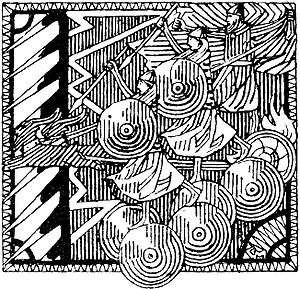Thorkell the Tall

Thorkell the Tall, also known as Thorkell the High in the Anglo-Saxon Chronicle (Old Norse: Þorke(ti)ll inn hávi; Norwegian: Torkjell Høge; Swedish; Torkel Höge: Danish: Torkild den Høje), was a prominent member of the Jomsviking order and a notable lord. He was a son of the Scanian chieftain Strut-Harald, and a brother of Jarl Sigvaldi. Thorkell was the chief commander of the Jomvikings and the legendary stronghold, Jomsborg, on the Island of Wollin.
Biography
Thorkell is a historical figure, but his career, especially its early part, is steeped in associations with the legendary Jomsvikings. Thorkell took part in the Battle of Hjörungavágr in 986 and in the Battle of Swold in 1000. He attacked England in 1010, landing near Ipswich on the shores of the River Orwell at Nacton with a large army, defeating the local army sent from Ipswich. He was eventually paid an unusually large danegeld in 1011.
In September 1011, a Viking army led by Jarl Thorkell the Tall laid siege to the city of Canterbury for three weeks, until its defences were overwhelmed and the old cathedral burned down. Thorkell's men took Archbishop Ælfheah of Canterbury hostage, who had previously been instrumental in negotiating danegeld payments. It is said that Ælfheah refused to be exchanged for ransom organised by Eadric Streona as he did not wish to further impoverish his countrymen. As a consequence, he was murdered by Thorkell's men during a drunken feast. Sensing that he was losing control over his men, Thorkell and his loyalists defected. He and his men entered into the service of the English King Æthelred the Unready, whom they fought under in 1013 against the invasion of Danish King Sweyn Forkbeard and his son Cnut.[1]
After the death of Sweyn and the English attacks on the Danish invaders, which drove Cnut to abandon the conquest, King Æthelred's forces turned against the Vikings with whom he had made peace. Cnut's cousin Heming was killed by Æthelred's men, [2] Thorkell and Erik went back to Denmark, with a score to settle in England and to tell the news of Heming's death to King Cnut. Thorkell and Erik were to return to England with King Cnut in 1015, and the invasion's success meant Thorkell was proclaimed to be the Jarl of East Anglia, in 1017, after the coronation of Cnut as King of England.
In 1021, Thorkell had a falling out with Cnut and fled to Denmark.[3] This appears to have been as a result of a trial of his wife, who was found guilty of poisoning his son by his first marriage, with the help of a witch. Thorkell had sworn to her innocence and consequently lost face. He was soon reconciled with Cnut again, who proclaimed him Jarl of Denmark once more, although he seemed to disappear in 1023, as there is no mention of him after this point.[4] It may be he was simply too old for any more conflict, and the final years of his life spent at court, yet with no military commands. It may also be that he was cast out of the kingdom, to return to Jomsborg or Scania, and lived the rest of his days as a wayward old soldier. Equally, he may have died soon after he was made Jarl of Denmark.
Notes
- ↑ Howard, Ian, Swein Forkbeard's Invasions and the Danish Conquest of England, 991–1017, Boydell & Brewer (2003), pg. 44
- ↑ Trow, M.J., Cnut: Emperor of the North, first. edn., Sutton (2005), pg. 57
- ↑ Lawson, M.K., Cnut: England's Viking King, rev. edn., Tempus (2005), pg. 90
- ↑ Lawson, M.K., Cnut: England's Viking King, rev. edn., Tempus (2005), pg. 92
References
- Howard, Ian (2003) Swein Forkbeard's Invasions and the Danish Conquest of England, 991–1017 (Boydell & Brewer) ISBN 978-0851159287
- Lawson, M. K. (2011) Cnut: England's Viking King (The History Press) ISBN 978-0752460697
- Trow, M. J. (2005) Cnut: Emperor of the North (Sutton Publishing Ltd) ISBN 978-0750933872
Further reading
- Hollander, Lee Milton (1955). The Saga of the Jómsvíkings. ISBN 978-0-292-77623-4.
External links
Note
![]()
| Preceded by Ulfcytel Snillingr |
Earl of East Anglia 1017–1021 |
Succeeded by ? |